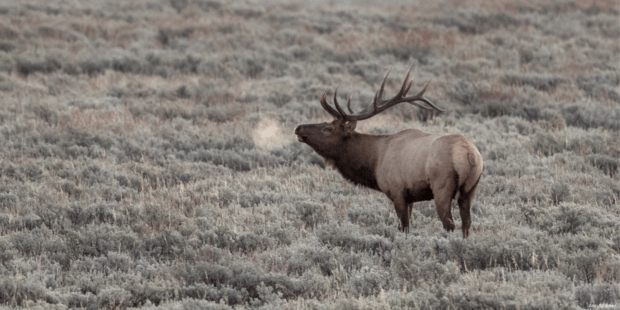We have much more to do and your continued support is needed now more than ever.
Energy dominance threatens America’s wildlife

The Trump administration’s energy dominance strategy is wreaking havoc on our nation’s public lands and wildlife. Areas once thought too sensitive to ever be considered for oil and gas and other industrial development are now routinely being offered up on the auction block, despite its impact on wildlife corridors and habitat.
In state after state, the administration has leased land that is in the middle of priority sage grouse habitat and in the middle of big game migration corridors, in violation of the administration’s own Secretarial Order 3622 which aims to conserve corridors. According to a report by the Center for American Progress, a fifth of the oil and gas leases offered by the administration intersect with big game migration corridors or wintering grounds for elk, mule deer or pronghorn. The most egregious example is New Mexico, where 80 percent of the oil and gas leases were in priority habitat for big game species.

Wyoming has a long history of oil and gas development. There are currently nearly 28,000 oil wells and 11,000 natural gas wells in production. The BLM has given the green light to another 13,598 new wells that will cover over two million acres. The amount of habitat that has been destroyed in Wyoming from oil and gas development could pave over the entire state of Rhode Island. And yet, still the leasing continues. The most recent oil and gas sale offered up parcels that intersected with the protected Red Desert-to-Hoback migration corridor, a 140-mile-long migration corridor for the Sublette mule deer herd. Another 200 parcels overlapped with crucial winter range for mule deer, elk and pronghorn.
It begs the question: when is enough enough?
Balancing our need for energy with sustainable wildlife populations and other important economic drivers is important. Like all Western states, the outdoor recreation industry produces more jobs than all extractive industries combined. Almost a quarter of Wyoming’s workforce is employed in the outdoor recreation industry, which is three times the number of people employed by oil and gas. Those 50,000 outdoor rec jobs generate $1.6 billion in wages and salaries. Another $5.6 billion is generated by consumer spending associated with outdoor recreation. (See more Wyoming oil and gas statistics here).
The rush to offer up leases is breathless. Where leases were once rotated every quarter between field offices, each office now conducts its own quarterly release. In Nevada the leases are being offered up monthly basis. It’s become the wild, wild West in Nevada where the administration has put more than 1.8 million acres of public land up for leasing since March of 2017, double the amount leased in the last 4 years of the Obama administration. Many of those leases are in sage grouse habitat, riparian areas and popular recreation sites, including the Ruby Mountains, sometimes called “the Swiss Alps” of the United States. Much of the land has low potential for oil and gas development but the leases get snapped up at rock bottom prices. Sometimes they aren’t even purchased during the sale and are sold in a non-competitive sales process bringing as little as $1.50 an acre. These leases then prevent the land from being managed for any other uses. Outside speculators are tying up these lands despite a massive outcry from local communities.
Adding more fuel to the fire is the deeply troubling appointment of William Perry Pendley ー an avowed anti-public lands zealot ー to be the de-facto director at the Bureau of Land Management (BLM). Clearly wishing to avoid the Constitutionally-mandated Senate scrutiny that an official appointment would require, the Trump administration has been using a backdoor approach, appointing Pendley for successive temporary appointments. For his entire career, Mr. Pendley has worked against public lands designations, against wildlife protections, even against career employees at the Bureau of Land Management. At the same time, he’s worked to promote the sell-off of public lands and advance oil and gas development. In less than two months at the helm of BLM, Mr. Pendley has already given away 500 acres of public land to build the border wall with Mexico.
This administration is also planning for the long term destruction of America’s public lands. All across the West, the Bureau of Land Management is releasing new Resource Management Plans (RMPs) that will guide land management on public lands for the next 25 years or more. In virtually every case, the new plans eliminate protections for critical wildlife habitat, encourage rampant energy development and ignore any sense of balanced use, while disregarding the input of local communities that engaged in years of painstaking planning. Often the new plans ignore Areas of Critical Environmental Concern designations made previously by the agency.
Left unchecked, the administration’s energy dominance agenda threatens to destroy some of America’s last great places. Here are just a few of the most egregious examples of RMPs that have been released by the current administration.

WORLD CLASS HUNTING IN MONTANA – The Bureau of Land Management’s Lewistown office oversees 650,000 acres of spectacular public land in central Montana along the Missouri River. This land supports elk, deer, pronghorn, bighorn sheep and some of the finest big game hunting in the world. In 2016, BLM officials completed a draft resource management plan which would have recommended protection of 100,000 acres of land with wilderness characteristics and preserved eight areas of environmental concern and was written with input from the public. That draft was never released. In May of this year, the Trump administration released a rewritten RMP which failed to recommend protection of any lands with wilderness characteristics, eliminated the eight areas of environmental concern and opened up 99 percent of the land to oil and gas development putting wildlife, cultural, geological and paleontological treasures at risk.
SPECTACULAR CAVERNS IN NEW MEXICO – BLM management plans for the Carlsbad region of New Mexico cover 6 million acres of deserts, grasslands, mountain ranges and underground caves. An earlier draft of the RMP had protections for critical habitat. That plan was rewritten by the Trump administration so that it now focuses almost exclusively on oil and gas development. The new RMP ignores areas of critical environmental concern that include Great Blue Heron habitat, unique salt playas and grasslands with one of the nation’s highest diversity of bird species. Also at risk: over 10,000 years of human history including prehistoric carvings. The most serious threat is that oil and gas drilling could contaminate the groundwater and over 100 miles of caves at Carlsbad Caverns National Park.

DIVERSE WILDLIFE HABITAT IN IDAHO – The Four Rivers area in southwestern Idaho draws outdoor enthusiasts every year to raft, kayak, hike, hunt, fish, and enjoy spectacular scenery that includes mountains, desert, sagebrush and some 280 miles of rivers and streams. The BLM’s new management plan for the area would eliminate nearly 20,000 acres of critical environmental concern even though these lands are home to imperiled species such as the long-billed curlew, pygmy rabbits, Canada lynx, Townsend’s big-eared bats and sage grouse. Oil and gas development near sage grouse habitat is particularly concerning. A recent report showed that the sage grouse populations in Idaho have decreased 52 percent since 2016.
CRITICAL WILDLIFE CORRIDORS IN COLORADO – The Uncompahgre plateau in southwestern Colorado covers nearly three-quarters of a million acres of surface land and 971,220 acres of federal mineral estate. The recently released BLM plan would remove wildlife protections for the threatened Gunnison sage grouse, cutthroat trout and bighorn sheep. It opens up 872,000 acres to oil and gas development and 371,000 acres to coal development. The plan, released in June, was a complete rewrite of plans that had been developed with the local community over the past several years. The new plan is in direct conflict with its own guidance to protect wildlife corridors and in direct conflict with state directives to protect wildlife habitat and migration corridors. Governor Polis and the director of Colorado’s Department of Natural Resources have vigorously protested this new plan for the damage it will inflict on wildlife and the climate. By some estimates, the new plan will result in more than a half billion tons of new climate pollution over 20 years.
LAST WILD AREAS IN CALIFORNIA – Just last week, the administration announced it would open up 725,000 acres of land in California’s central valley and coast to oil and gas development, which would have devastating impacts on air and water quality and wildlife habitats. The new plan allows oil and gas development in the Santa Cruz Mountains and across 11 counties—many which have bans on fracking. A 2015 report from the California Council on Science and Technology showed that fracking in this area has a high potential for contaminating drinking water supplies with toxic chemicals. The new BLM plan runs completely counter to state policies encouraging a switch to clean energy sources.
NATIONAL PARKS IN UTAH — Today the National Parks Conservation Association issued a report about threats to 12 national parks from oil and gas development. Many are located in Utah, which has seen a tremendous spike in leasing under the Trump administration. In 2017 the BLM leased 17,000 acres of land just outside Arches and Canyonlands National Parks, despite objections from park officials who argued that it would have a detrimental effect on air quality. In 2018, the BLM offered up 200,000 acres near Canyonlands which threaten the landscape, wildlife and ancient rock art. The average price paid for many of those leases? Just $2 an acre.
For more information on energy dominance in the West, contact Mary Jo Brooks, communications manager for public lands, NWF, at brooksm@nwf.org or 303-441-5144.





















